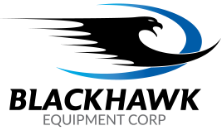Planning for Holiday Shutdowns: A Comprehensive Maintenance Guide for Your Utility Systems
09/10/2025

For many industrial facilities, the end-of-year holiday season provides a rare and valuable opportunity: a scheduled shutdown. This brief window, free from the relentless pressure of production quotas, is the perfect time to perform the deep, intrusive maintenance on your critical utility systems that is simply impossible during normal operation. As engineers and maintenance managers, viewing this period not as "downtime" but as a strategic "investment in uptime" is crucial for ensuring a reliable and efficient start to the new year. A successful shutdown, however, doesn't happen by accident. It requires meticulous planning that, for a December shutdown, needs to start right now, in September. At Blackhawk Equipment, we partner with our clients to plan and execute these critical maintenance activities, turning a quiet period into a powerful tool for enhancing plant reliability.
The Strategic Value of a Planned Maintenance Shutdown

A well-executed shutdown allows your team to move beyond the constraints of routine preventive maintenance (PMs) and address the core health of your equipment.
-
Going Beyond Routine PMs: While routine PMs are essential, they are often limited to tasks that can be completed in a few hours. A shutdown allows for major, time-intensive work like motor bearing replacements, internal inspections of pressure vessels, or comprehensive heat exchanger cleaning.
-
Preempting Catastrophic Failures: Intrusive inspections during a shutdown often uncover developing issues—like bearing wear, internal corrosion, or fouled coolers—long before they can lead to a catastrophic, unscheduled failure during peak production.
-
Restoring System Efficiency: Over a year of operation, system efficiency inevitably degrades. A shutdown is the ideal time to perform tasks like major leak repairs, system cleaning, and component calibrations that restore your utility systems to their peak operating efficiency, generating energy savings for the entire following year.
The Planning Phase: A 3-Month Blueprint for a Smooth Shutdown
The key to a stress-free and effective shutdown is advance planning. Waiting until November is too late. Here is a blueprint to follow, starting now.
Step 1 (September): Assemble the Team and Define the Scope:
-
Gather your key stakeholders: maintenance supervisors, lead technicians, operations managers, and engineering. Review the maintenance backlog from your CMMS, operator logs, and any data from predictive maintenance or system monitoring tools. Create a comprehensive "wish list" of all desired maintenance tasks.
Step 2 (Late September/Early October): Prioritize the Worklist:
You likely won't have time for everything on your wish list. Prioritize tasks using a risk-based approach:
-
Priority 1: Safety and Compliance: Any tasks related to safety systems, pressure relief valve testing, or regulatory compliance.
-
Priority 2: Reliability-Critical: Tasks addressing known issues or components nearing the end of their service life that could cause a major failure (e.g., a compressor air-end with high vibration).
-
Priority 3: Efficiency and Optimization: Projects that will improve energy efficiency, such as major leak repairs or heat exchanger cleaning.
-
Priority 4: Standard PMs and General Tasks: Routine maintenance that aligns with the shutdown window.
Step 3 (October): Order Parts and Secure Resources:
-
This step is critical. Lead times for major components like large motors, custom seals, or compressor air-ends can be weeks or even months. As of late 2025, supply chains still demand advance planning. Order all necessary parts and consumables now.
-
Schedule your resources. Determine which tasks will be handled by your in-house team and which require specialized external support. This is the time to book expert service technicians from partners like Blackhawk Equipment. Also, arrange for any necessary rental equipment, such as a temporary compressor to keep a critical part of the plant online.
Step 4 (November): Develop the Detailed Schedule and Safety Plan:
-
Create a detailed, hour-by-hour schedule for the shutdown period. Develop specific, documented Lockout/Tagout (LOTO) procedures for each major job. Hold pre-shutdown safety briefings to ensure every team member understands the plan and the potential hazards.
Your Utility Systems Shutdown Maintenance Checklist
Here is a detailed checklist of potential tasks to consider for your primary utility systems:
Compressed Air System:
Air Compressors:
-
Perform major interval service (e.g., 4000, 8000-hour PMs).
-
Conduct a detailed inspection of the air-end; consider a replacement if hours are high or vibration analysis indicates wear.
-
Lubricate or replace main motor and fan motor bearings.
-
Perform a comprehensive cleaning or chemical flush of the oil cooler and aftercooler.
-
Inspect and test all safety devices, including high-temperature and high-pressure shutdowns.
-
Inspect the separator tank for any signs of internal corrosion.
Air Dryers:
-
For refrigerated dryers, thoroughly clean the condenser coils and pre-filter.

-
For desiccant dryers, test the desiccant for moisture saturation; replace if necessary. Inspect and service switching valves and purge mufflers.
Air Receivers:
-
Test the pressure relief valve to ensure it functions correctly.
-
Verify the automatic drain is working flawlessly.
-
Perform an internal inspection for corrosion, as required by your local regulations.
System-Wide:
-
This is the perfect time for major leak repair campaigns in the piping system.
-
Replace all coalescing and particulate filter elements throughout the system.
Industrial Pumping Systems:
-
Pumps: Lubricate or replace motor bearings. Inspect mechanical seals for any signs of leakage and replace if necessary. Inspect the impeller for signs of wear, corrosion, or cavitation damage.
-
Alignment: Perform a precision laser alignment check between the pump and motor. Misalignment is a primary cause of premature bearing and seal failure.
-
Valves: Inspect, clean, and exercise (fully open and close) critical isolation and check valves in the system to ensure they operate properly.
Process Cooling Systems (Chillers & Towers):
-
Chillers: Schedule professional service for eddy current testing of condenser and evaporator tubes to detect potential leaks. Take refrigerant and oil samples for laboratory analysis. Calibrate all sensors and safety controls.
-
Cooling Towers: This is the ideal time for a deep clean. Drain and clean the tower basin to remove sludge and sediment. Inspect the fill media for damage or scaling. Inspect the fan gearbox, motor, and blades.
Blackhawk Equipment: Your Expert Shutdown Partner
Executing a successful shutdown on complex utility equipment requires specialized expertise. Blackhawk Equipment is your ideal partner to ensure this critical maintenance is done right.
-
Pre-Shutdown Planning: We can work with you in the planning months to assess your equipment's condition and help you build a detailed, prioritized maintenance scope.
-
Securing Genuine OEM Parts: We can ensure you have all the correct, genuine OEM parts for your Sullair, Grundfos, Aerzen, and other critical equipment on hand before the shutdown begins.
-
Providing Expert Technicians: Our factory-trained service technicians can be scheduled to perform the most complex tasks, from compressor air-end services to precision pump alignments, freeing up your team for other jobs.
-
Offering Rental Equipment: If a portion of your plant needs to remain operational, we can provide temporary rental compressors, dryers, or pumps to support those critical loads.
Conclusion: Turn Downtime into a Competitive Advantage
A planned holiday shutdown is a golden opportunity to reset the reliability clock on your plant's most critical systems. It allows you to move from a reactive to a proactive maintenance stance, preventing failures before they happen. Success, however, is entirely dependent on meticulous planning that begins months in advance. By using this time wisely to perform deep, restorative maintenance, you can ensure your facility starts the new year with its utility systems in peak condition, ready to support a full year of efficient and reliable production.
Don't wait until the last minute. Contact Blackhawk Equipment now to start planning your end-of-year shutdown maintenance. Let our experts help you turn your planned downtime into a powerful competitive advantage.
